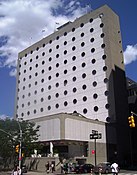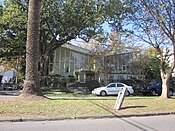Albert C. Ledner
Albert C. Ledner | |
|---|---|
| Born | January 28, 1924 Bronx, New York |
| Died | November 14, 2017 (aged 93) |
| Nationality | American |
| Alma mater | Tulane University |
| Occupation | Architect |
| Projects | National Maritime Union |
| Design | Organic modernism |
Albert Charles Ledner (January 28, 1924 – November 14, 2017) was an
Personal life and education
Ledner was born in
Following completion of his
Architectural career
| External images | |
|---|---|
| Images of the Albert C. Ledner | |
Ledner started his independent architectural career in 1951, spending most of his professional career in New Orleans. Through his career as an architect, he followed the "design-build" approach in which the architect remains involved during the construction phase of the project. In this approach, Ledner devised uncommon approaches to structure and uses of construction materials. By remaining involved in the construction phase of the project, he further could revise details in ways not possible in conventional approaches in which the architect is minimally involved in the construction phase of a project. At times, his designs were characterized as quirky while also functional and expressive.
National Maritime Union projects
In 1954, Ledner designed and built the National Maritime Union building in New Orleans. The success of the New Orleans project led to his being hired for the much larger National Maritime Union project in New York City.[6] In 1957, he designed and built his own home at 5328 Bellaire Drive in the Lakewood South neighborhood of New Orleans.[6] He lived in this home with his wife and children until the time of his death. The home flooded in 2005 as a result of Hurricane Katrina and was subsequently restored.[3]
The success of the National Maritime Union building in New Orleans led to Ledner's commission in 1958 to design the headquarters for the National Maritime Union building in New York City. The National Maritime Union was flourishing at the time and had need for a headquarters that included offices, hiring halls, residences and training centers for the union members. The first of these buildings was the headquarters of the National Maritime Union located at Seventh Avenue between 12th and 13th Streets. This six-story building was built on two glass block cylinders. It has walls with overhangs and windows suggestive of portholes, intended to be fitting for a hiring hall of maritime sailors.[7]
The second building in Ledner's New York City National Maritime Union project was an annex at 346 West 17th Street, consisting of an eleven-story building with 100 porthole windows on a sloping wall. The last of this project was an annex on Ninth Avenue between 16th and 17th Streets said to look like a pizza box with porthole windows. With the decline of the maritime trade unions by the early 1970s, the union sold these buildings and were subsequently converted to alternative uses.[7]
Ledner designed buildings for similar purposes in Mobile, Alabama; Baltimore, Maryland; Houston, Texas; Galveston, Texas; Norfolk, Virginia; and San Francisco, California. He also designed a building for the
Residential projects
The Kleinschmidt Residence in the
Another of Ledner's early residential projects was the Cointreau House, also in the Park Island neighborhood of New Orleans. This house included skylights and light fixtures fabricated from Cointreau liqueur bottles. This home was featured in the June 1953 issue of House Beautiful magazine.[10]
In 1961, Ledner designed and built a residence on Park Island in New Orleans that came to be known as the "Sunkel House" or the "Ashtray House". A distinguishing feature of this home is its use of 1200 amber-colored glass ashtrays as
Other Ledner residential designs included the Goldate House and the Leonard House, both in New Orleans.[8]
Legacy
In addition to architectural projects, Ledner designed and built household and office equipment such as light fixtures, tables, and artwork. He also designed various machines for which he obtained three patents.[6] An example of his patented inventions is an emergency descent device to aid people in escaping from tall buildings.[11]
In 2016,
Principal architectural works
- First Unitarian Universalist Church, 1800 Jefferson Avenue, New Orleans, Louisiana (completed 1957; extant, but as of 2017 a residence).
- National Maritime Union office building, 2731 Tchoupitoulas Street, New Orleans, Louisiana (1954).
- National Maritime Union Headquarters, Joseph Curran Building, 36 Seventh Avenue between W 12th and W 13th Streets, New York City (completed in 1964).
- National Maritime Union, Curran Annex, 355 W 16th Street between Eighth and Ninth Avenues, New York City (completed in 1966;[13] altered in 2007 for use as Dream Hotel).
- National Maritime Union, Curran Plaza, 363 West 16th Street at 9th Avenue, New York City (completed in 1968).
Gallery
-
National Maritime Union Headquarters, New York City (completed in 1964)
-
National Maritime Union, Curran Plaza, New York City (completed in 1968; converted in 2003 to Maritime Hotel)
-
National Maritime Union Building in New Orleans (completed in 1954; houses small businesses as of 2019)
-
Unitarian Church on Jefferson Avenue in New Orleans (completed in 1958; converted to a residence following relocation of the church)
Notes
- ^ Ledner and Leonard Spangenberg were the two Wright-trained architects in New Orleans.
References
- ^ a b Langenhennig, Susan (March 6, 2018). "Architect Albert Ledner's Star-Shaped New Orleans Home Hits the Market for $829,500". New Orleans Times-Picayune. Retrieved 4 November 2019.
- ^ a b Langenhennig, Susan (August 24, 2017). "Albert Ledner's Legacy: New Orleans Architect Peppered the Country with Modernist Marvels". New Orleans Times-Picayune. Retrieved 6 November 2019.
- ^ a b Lind, Angus (November 9, 2008). "His Structured Life: Architect Albert Ledner's Story is Icing on the Doberge Cake". New Orleans Times-Picayune.
- ^ "Curran / O'Toole Building" (PDF). docomomo-nytri.org. DOCOMOMO US/New York Tri-State. Retrieved 14 November 2019.
- ^ a b Dixon, John Morris. "Remembering Albert C. Ledner, pioneering New Orleans modernist". archpaper.com. The Architect's Newspaper, LLC. Retrieved 12 November 2019.
- ^ a b c "Albert Charles Ledner 1924-2017". legacy.com. Retrieved 11 November 2019.
- ^ a b Gray, Christopher (November 25, 2007). "An Architect's Flotilla of West Side Buildings". The New York Times. The New York Times. Retrieved 14 November 2019.
- ^ a b Chaban, Matt A. V. (14 December 2016). "Meet Albert Ledner, Midcentury Mastermind and Frank Lloyd Wright Acolyte". curbed.com. Vox Media. Retrieved 14 November 2019.
- ^ Murret, Patricia M. (August 27, 2014). "A 1951 Home Designed by Modernist Architect Albert Ledner Still Shines in Lake Vista". New Orleans Times-Picayune. Retrieved 16 November 2019.
- ^ Langenhennig, Susan. "See More of Modernist Architect Albert Ledner's Work". New Orleans Times-Picayune. Retrieved 16 November 2019.
- ^ A. Ledner, US3826341A, September 11, 1973.
- ^ "Albert Ledner, Architect With a Quirky Sense, Dies at 93". The New York Times. November 21, 2017. Retrieved November 21, 2017.
- ^ NYC Temporary Certificate of Occupancy No. 63141, May 25, 1966.
External links
- Trailer for documentary film, "Designing for Life: The Modernist Architecture of Albert C. Ledner".
- Photographs of Ledner at various stages of his life and photographs of various Ledner projects while they were under construction can be seen on-line.
- Tulane University maintains a set of on-line exhibits on Ledner's work.




